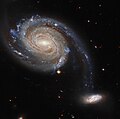Fișier:NGC7752, NGC7753 - HST - Potw2142a.jpg

Mărimea acestei previzualizări: 604 × 600 pixeli. Alte rezoluții: 242 × 240 pixeli | 483 × 480 pixeli | 774 × 768 pixeli | 1.031 × 1.024 pixeli | 2.063 × 2.048 pixeli | 3.908 × 3.880 pixeli.
Mărește rezoluția imaginii (3.908 × 3.880 pixeli, mărime fișier: 3,2 MB, tip MIME: image/jpeg)
Istoricul fișierului
Apăsați pe Data și ora pentru a vedea versiunea trimisă atunci.
| Data și ora | Miniatură | Dimensiuni | Utilizator | Comentariu | |
|---|---|---|---|---|---|
| actuală | 18 octombrie 2021 07:11 |  | 3.908x3.880 (3,2 MB) | Fabian RRRR | == {{int:filedesc}} == {{Information |description={{en|1='''Invisible Galactic Gale NGC 4666 takes centre stage in this image from the NASA/ESA Hubble Space Telescope. This majestic spiral galaxy lies about 80 million light-years away in the constellation Virgo, and is undergoing a particularly intense episode of star formation. Astronomers refer to galaxies which are forming stars anomalously quickly as starburst galaxies. NGC 4666’s starburst is thought to be due to gravitational interact... |
Utilizarea fișierului
Utilizarea globală a fișierului
Următoarele alte proiecte wiki folosesc acest fișier:
- Utilizare la az.wikipedia.org
- Utilizare la be.wikipedia.org
- Utilizare la ce.wikipedia.org
- Utilizare la de.wikipedia.org
- Utilizare la diq.wikipedia.org
- Utilizare la en.wikipedia.org
- Utilizare la eu.wikipedia.org
- Utilizare la fa.wikipedia.org
- Utilizare la fr.wikipedia.org
- Utilizare la mg.wikipedia.org
- Utilizare la mk.wikipedia.org
- Utilizare la ru.wikipedia.org
- Utilizare la sk.wikipedia.org
- Utilizare la tt.wikipedia.org
- Utilizare la www.wikidata.org